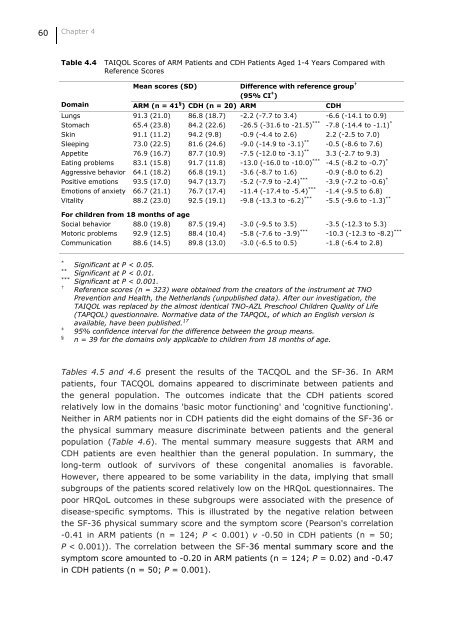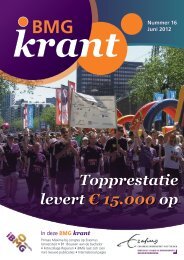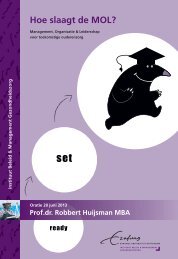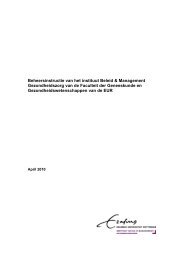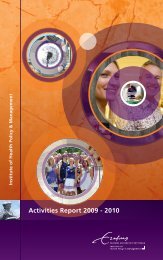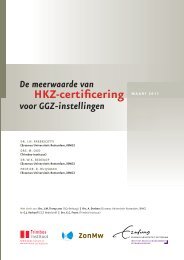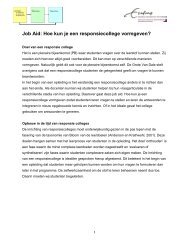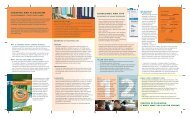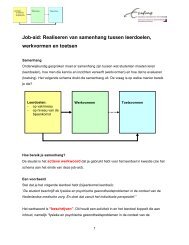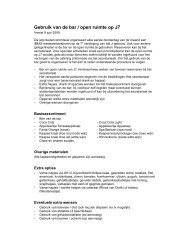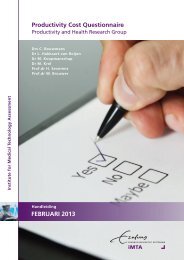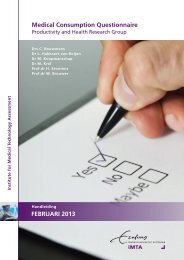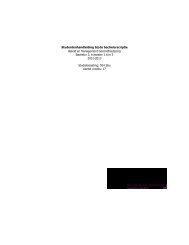Marten J. Poley - Erasmus Universiteit Rotterdam
Marten J. Poley - Erasmus Universiteit Rotterdam
Marten J. Poley - Erasmus Universiteit Rotterdam
- No tags were found...
Create successful ePaper yourself
Turn your PDF publications into a flip-book with our unique Google optimized e-Paper software.
60Chapter 4Table 4.4TAIQOL Scores of ARM Patients and CDH Patients Aged 1-4 Years Compared withReference ScoresMean scores (SD) Difference with reference group †(95% CI ‡ )Domain ARM (n = 41 § ) CDH (n = 20) ARM CDHLungs 91.3 (21.0) 86.8 (18.7) -2.2 (-7.7 to 3.4) -6.6 (-14.1 to 0.9)Stomach 65.4 (23.8) 84.2 (22.6) -26.5 (-31.6 to -21.5) *** -7.8 (-14.4 to -1.1) *Skin 91.1 (11.2) 94.2 (9.8) -0.9 (-4.4 to 2.6) 2.2 (-2.5 to 7.0)Sleeping 73.0 (22.5) 81.6 (24.6) -9.0 (-14.9 to -3.1) ** -0.5 (-8.6 to 7.6)Appetite 76.9 (16.7) 87.7 (10.9) -7.5 (-12.0 to -3.1) ** 3.3 (-2.7 to 9.3)Eating problems 83.1 (15.8) 91.7 (11.8) -13.0 (-16.0 to -10.0) *** -4.5 (-8.2 to -0.7) *Aggressive behavior 64.1 (18.2) 66.8 (19.1) -3.6 (-8.7 to 1.6) -0.9 (-8.0 to 6.2)Positive emotions 93.5 (17.0) 94.7 (13.7) -5.2 (-7.9 to -2.4) *** -3.9 (-7.2 to -0.6) *Emotions of anxiety 66.7 (21.1) 76.7 (17.4) -11.4 (-17.4 to -5.4) *** -1.4 (-9.5 to 6.8)Vitality 88.2 (23.0) 92.5 (19.1) -9.8 (-13.3 to -6.2) *** -5.5 (-9.6 to -1.3) **For children from 18 months of ageSocial behavior 88.0 (19.8) 87.5 (19.4) -3.0 (-9.5 to 3.5) -3.5 (-12.3 to 5.3)Motoric problems 92.9 (12.5) 88.4 (10.4) -5.8 (-7.6 to -3.9) *** -10.3 (-12.3 to -8.2) ***Communication 88.6 (14.5) 89.8 (13.0) -3.0 (-6.5 to 0.5) -1.8 (-6.4 to 2.8)***Significant at P < 0.05.Significant at P < 0.01.*** Significant at P < 0.001.†Reference scores (n = 323) were obtained from the creators of the instrument at TNOPrevention and Health, the Netherlands (unpublished data). After our investigation, theTAIQOL was replaced by the almost identical TNO-AZL Preschool Children Quality of Life(TAPQOL) questionnaire. Normative data of the TAPQOL, of which an English version isavailable, have been published. 17‡§95% confidence interval for the difference between the group means.n = 39 for the domains only applicable to children from 18 months of age.Tables 4.5 and 4.6 present the results of the TACQOL and the SF-36. In ARMpatients, four TACQOL domains appeared to discriminate between patients andthe general population. The outcomes indicate that the CDH patients scoredrelatively low in the domains 'basic motor functioning' and 'cognitive functioning'.Neither in ARM patients nor in CDH patients did the eight domains of the SF-36 orthe physical summary measure discriminate between patients and the generalpopulation (Table 4.6). The mental summary measure suggests that ARM andCDH patients are even healthier than the general population. In summary, thelong-term outlook of survivors of these congenital anomalies is favorable.However, there appeared to be some variability in the data, implying that smallsubgroups of the patients scored relatively low on the HRQoL questionnaires. Thepoor HRQoL outcomes in these subgroups were associated with the presence ofdisease-specific symptoms. This is illustrated by the negative relation betweenthe SF-36 physical summary score and the symptom score (Pearson's correlation-0.41 in ARM patients (n = 124; P < 0.001) v -0.50 in CDH patients (n = 50;P < 0.001)). The correlation between the SF-36 mental summary score and thesymptom score amounted to -0.20 in ARM patients (n = 124; P = 0.02) and -0.47in CDH patients (n = 50; P = 0.001).


